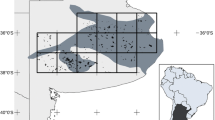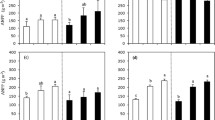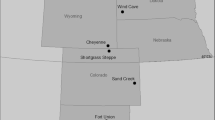Summary
An “environmental productivity index” based on physiological responses to three environmental variables was used to predict the net productivity of a common succulent perennial of the Sonoran Desert, Agave deserti, on a monthly basis. Productivity was also independently measured in the field from dry weight changes. The index was based on soil water availability, day/night air temperatures, and photosynthetically active radiation (PAR), which were individually varied in the laboratory and the effect on net CO2 uptake by the leaves determined. From monthly precipitation, temperature, and PAR at the field site together with the responses measured in the laboratory, an index (maximum value of unity) was assigned to each of these three environmental variables and their product was termed the environmental productivity index. This index indicates the fraction of maximal CO2 uptake expected in the field for each month (well-watered A. deserti assimilated 285 mmol CO2 m-2 leaf area day-1 at PAR saturation and optimal day/night temperatures of 25° C/15° C). The dry weight analysis was based on the monthly unfolding of new leaves from the central spike of the rosette and their seasonal increase in dry weight, which were determined in the field. The production of new leaves was highly correlated with the environmental productivity index (r2=0.93), which in turn was highly correlated with the water status index (r2=0.97). After correction for respiration by folded leaves, stem, and roots, plant productivity predicted by the average environmental productivity index (0.36) over a wet June-to-October period agreed within 4% with the productivity based on the conventional dry weight analysis. The net productivity of A. deserti over this 5-month period was 0.57 kg m-2 ground area (5.7 Mg ha-1), a large value for a desert CAM plant. The environmental productivity index proposed here may provide a reliable means for predicting net productivity on a monthly basis, which may be particularly useful for species in relatively variable environments such as deserts.
Similar content being viewed by others
References
Acevedo E, Badilla I, Nobel PS (1983) Water relations, diurnal acidity changes, and productivity of a cultivated cactus, Opuntia ficus-indica. Plant Physiol 72:775–780
Ehleringer J (1983) Ecophysiology of Amaranthus palmeri, a Sonoran desert summer annual. Oecologia 57:107–112
Ehleringer J, Mooney HA (1983) Productivity of desert and mediterranean-climate plants. In: Lange OL, Nobel PS, Osmond CB, Ziegler H (eds) Encyclopedia of plant physiology, new series, Vol 12D, Springer, Berlin Heidelberg New York, pp 205–231
Eickmeier WG, Adams MS (1978) Gas exchange in Agave lecheguilla Torr. (Agavaceae) and its ecological implications. Southwest Nat 23:473–486
Evans LT (ed) (1975) Crop physiology: some case histories. Cambridge University Press, Cambridge
Fischer RA, Turner NC (1978) Plant productivity in the arid and semiarid zones. Annu Rev Plant Physiol 29:277–317
Hoagland DR, Arnon DI (1950) The water-culture method for growing plants without soil. Cal Agric Exp Stn Circ 347:1–32
Jordan PW, Nobel PS (1979) Infrequent establishment of seedlings of Agave deserti (Agavaceae) in the northwestern Sonoran Desert. Am J Bot 66:1079–1084
Leith H, Whittaker RH (eds) (1975) Primary productivity in the biosphere. Ecological studies, Vol 14. Springer, New York Berlin Heidelberg
Lewis DA, Nobel PS (1977) Thermal energy exchange model and water loss of a barrel cactus, Ferocactus acanthodes. Plant Physiol 60:609–616
Milthorpe FL, Moorby J (1979) An introduction to crop physiology, 2nd ed. Cambridge University Press, Cambridge
Nobel PS (1976) Water relations and photosynthesis of a desert CAM plant, Agave deserti. Plant Physiol 58:576–582
Nobel PS (1977a) Water relations of flowering of Agave deserti. Bot Gaz 138:1–6
Nobel PS (1977b) Water relations and photosynthesis of a barrel cactus, Ferocactus acanthodes, in the Colorado Desert. Oecologia (Berl) 27:117–133
Nobel PS (1983) Biophysical plant physiology and ecology, WH Freeman, New York
Nobel PS (1984a) Extreme temperatures and thermal tolerances for seedlings of desert succulents. Oecologia (Berl) 62:310–317
Nobel PS (1984b) Environmental responses of agaves—a case study with Agave deserti. In: Simposio Internacional sobre Problemas y Perspectivas de la Biologia y Aprovechamiento Integral del Henequen y otros Agaves, CONACYT y CICY, Mexico
Nobel PS, Hartsock TL (1978) Resistance analysis of nocturnal carbon dioxide uptake by a Crassulacean acid metabolism succulent, Agave deserti. Plant Physiol 61:510–514
Nobel PS, Hartsock TL (1979) Environmental influences on open stomates of a Crassulacean acid metabolism plant, Agave deserti. Plant Physiol 63:63–66
Noy-Meir I (1973) Desert ecosystems: environment and producers. Annu Rev Ecol Syst 4:25–51
Schulze E-D, Lange OL, Kappen L, Evenari M, Buschbom U (1975) Physiological basis of primary production of perennial higher plants in the Negev desert. In: Cooper JP (ed) Photosynthesis and productivity in different environments, Cambridge University Press, Cambridge, pp 107–119
Smith SD, Nobel PS (1985) Deserts. In: Baker NR, Long SP (eds), Photosynthesis in specific environments. Topics in photosynthesis. Vol 7, Elsevier, Amsterdam (in press)
Szarek SR, Ting IP (1974) Seasonal patterns of acid metabolism and gas exchange in Opuntia basilaris. Plant Physiol 54:76–81
Webb WL, Lauenroth WK, Szarek SR, Kinerson RS (1983) Primary production and abiotic controls in forests, grasslands, and desert ecosystems in the United States. Ecology 64:134–151
Woodhouse RM, Williams JG, Nobel PS (1980) Leaf orientation, radiation interception, and nocturnal acidity increases by the CAM plant Agave deserti (Agavaceae). Am J Bot 67:1179–1185
Woodhouse RM, Williams JG, Nobel PS (1983) Simulation of plant temperature and water loss by the desert succulent, Agave deserti. Oecologia (Berl) 57:291–297
Author information
Authors and Affiliations
Rights and permissions
About this article
Cite this article
Nobel, P.S. Productivity of Agave deserti: measurement by dry weight and monthly prediction using physiological responses to environmental parameters. Oecologia 64, 1–7 (1984). https://doi.org/10.1007/BF00377535
Received:
Issue Date:
DOI: https://doi.org/10.1007/BF00377535




